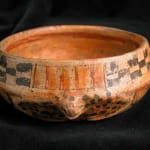Mayan Frog Effigy Bowl, 300 CE - 900 CE
Terracotta
4.5 x 2
PF.5851
Further images
In Mayan mythology, the frog is a powerful symbol of fertility and rebirth, revered for its amphibious nature. The lifecycle of the frog, from aquatic tadpole to terrestrial frog, is...
In Mayan mythology, the frog is a powerful symbol of fertility and rebirth, revered for its amphibious nature. The lifecycle of the frog, from aquatic tadpole to terrestrial frog, is a potent example of an animal’s ability to live in between two worlds. Thus, the choice of a frog to decorate a funerary vessel is quite fitting. For as we watch the tadpole emerge from the water to become a frog, so our spirits shall emerge from our bodies upon death and journey into the realm of the afterlife. In this way, the frog acts as a guide, ensuring fertility and success in the afterworld. Stylistically, the shape of the frog has been adapted to the form of the vessel. The creature’s head slightly projects from the side of the bowl, as do the crouching legs. On the opposite end, the tail takes the place of the head. The area around the frog has been decorated by a series of black spots, no doubt imitating the pattern of the frog’s skin. The rest of the vessel has been colorfully painted with various abstract motifs including a checkerboard pattern. Found in a tomb, buried along side a fallen ruler or dignitary, this vessel was as important in the afterlife as it was in this world.







